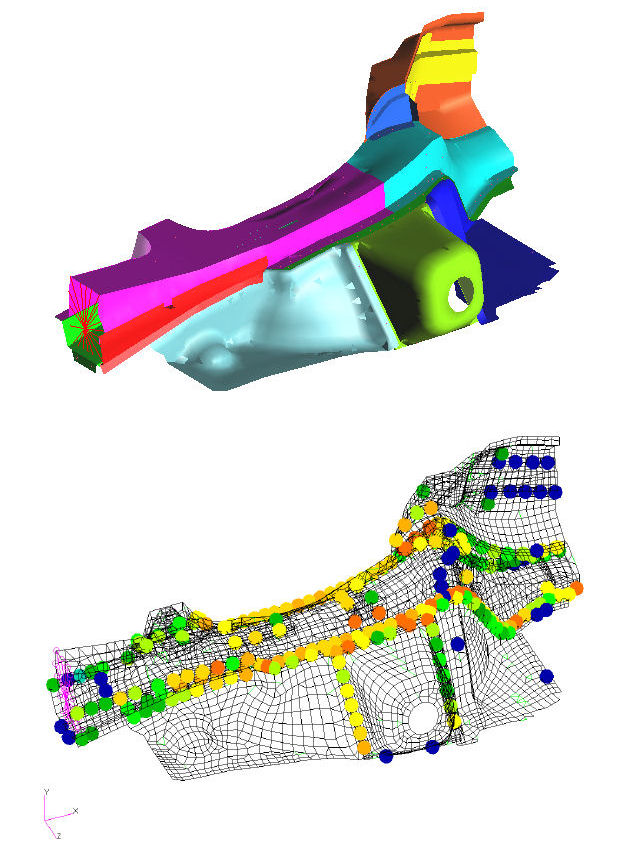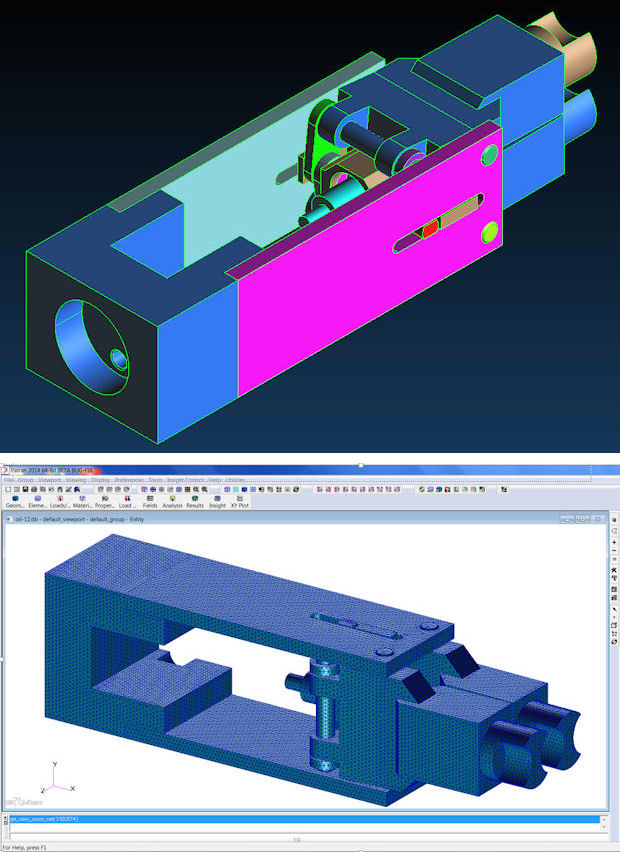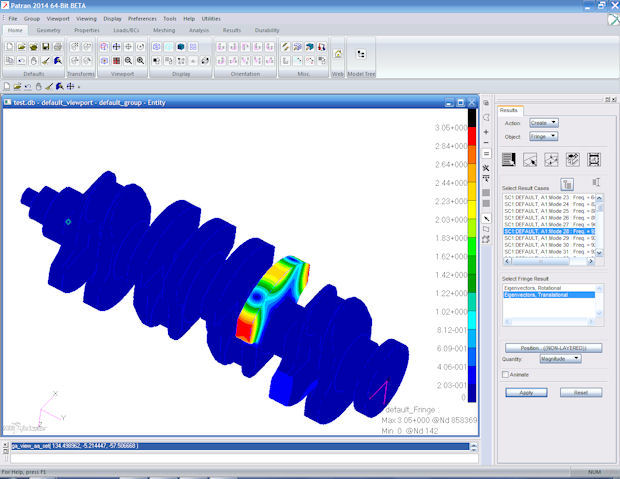December 17, 2014
MSC Software Corp. recently released the 2014 versions of its MSC Nastran multidisciplinary structural analysis application and its Patran FEA (finite element analysis) modeling solution. With the 2014 version, MSC Nastran introduces updated solver embedded fatigue functionality, performance improvements and enhanced ease of use. Patran now supports new fatigue analysis capabilities and nonlinear analysis improvements.
 MSC Nastran 2014 embedded fatigue capabilities have been extended with support for seam and spot welds fatigue analysis. The screen images here depict a spot weld fatigue analysis of an automotive component. Image courtesy of MSC Software Corp.
MSC Nastran 2014 embedded fatigue capabilities have been extended with support for seam and spot welds fatigue analysis. The screen images here depict a spot weld fatigue analysis of an automotive component. Image courtesy of MSC Software Corp.Version 2014 sees MSC Nastran’s embedded fatigue capabilities extended with support for seam and spot welds fatigue analysis that, reports MSC, makes it easier to identify the critical welds in automobiles and similar structures subjected to repeated loads. Also implemented in this release are multi-axial assessments that reportedly deliver insight into the validity of standard stress-life or strain-life fatigue analyses. MSC Nastran’s embedded fatigue capabilities now support industry-standard remote parameter control (RPC) files, which can help engineers drive the load history based upon measured data, as well as 2-pass and 3-pass fatigue analyses. The company adds that version 2014 also provides improved performance for fatigue analyses with no loss in accuracy.
In addition to its embedded fatigue analysis updates, MSC Nastran 2014 delivers enhancements for linear, advanced nonlinear and explicit nonlinear analysis as well as for high-performance computing (HPC).
MSC Nastran’s external superelement (SE) linear analysis capability, which is designed to reduce the modeling effort for full vehicle analysis with duplicate assemblies such as aircraft engines attached to wings or landing gears attached to the fuselage, has been enhanced in version 2014 to provide engineers the ability to rotate, move or mirror a primary external SE. MSC explains this enhancement means that users can now activate or deactivate rigid elements in subcases and enhance flexibility in defining combinations of load cases.
MSC Nastran’s advanced nonlinear analysis contact capability for assembly modeling can be used to join discontinuous meshes or general contact, including friction and heat transfer. Version 2014 offers improved solutions for complex problems such as eigenvalue extraction on pre-stressed bodies encountered in wind turbines. Current users will note that they are no longer required to identify the master and slave body and can reduce dependency on the mesh size, which, MSC says, will lead to simplified setup times. Version 2014 also supports nonlinear analysis with linear perturbations.
 An assembly model import and mesh performed with MSC Software’s Patran pre- and post-processing solution for finite element analyses. MSC reports that the CAD import/export features in Patran 2014 are up to 25% faster than earlier releases. Image courtesy of MSC Software Corp.
An assembly model import and mesh performed with MSC Software’s Patran pre- and post-processing solution for finite element analyses. MSC reports that the CAD import/export features in Patran 2014 are up to 25% faster than earlier releases. Image courtesy of MSC Software Corp.For explicit nonlinear analyses, MSC Nastran 2014 has a new, enhanced partitioner for block Euler meshes, and defining the coupling surface between the fluid and surface has been updated, reports the company. Additionally, the performance of explicit nonlinear analyses on multi-core configurations has improved by a factor of two.
For HPC environments, model frequency response analysis has been improved in version 2014 with three times faster performance in frequency computations for non-symmetric systems. Exterior acoustics problems can be solved in a fraction of the time using MSC Nastran’s parallel Krylov solver. This method, adds the company, is particularly effective for frequency response analysis “where wall clock time can be reduced by over 95%.” Other enhancements include improvements to axisymmetric harmonic concentrated mass element, and new outputs for composite shell elements.
Version 2014 of the company’s Patran pre-/post-processing software for FEA provides support for the new capabilities of MSC Nastran and MSC Fatigue. Its CAD import/export feature sees improvements for recent CAD system updates and a 25% speed-up. Patran 2014 has been enhanced to provide faster visualization.
For more information on MSC Nastran 2014, click here.
Go here to learn more about Patran 2014.
Download a PDF overview of the MSC Nastran 2014 release.
Watch the MSC Nastran 2014 and Patran 2014 release overview webinar.
Check out a gallery of application images.
See why DE’s Editors selected MSC Nastran 2014 and Patran 2014 as their Pick of the Week.
Sources: Press materials received from the company and additional information gleaned from the company’s website.
Subscribe to our FREE magazine, FREE email newsletters or both!
About the Author
Anthony J. Lockwood is Digital Engineering’s founding editor. He is now retired. Contact him via [email protected].
Follow DE






